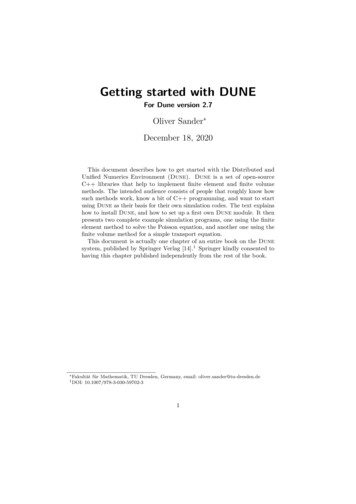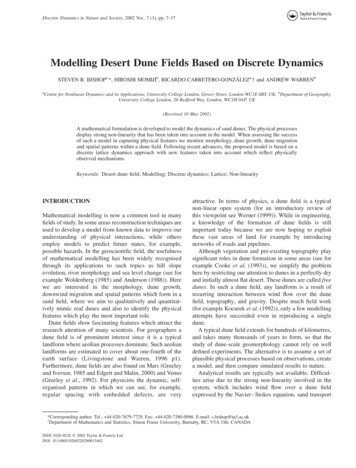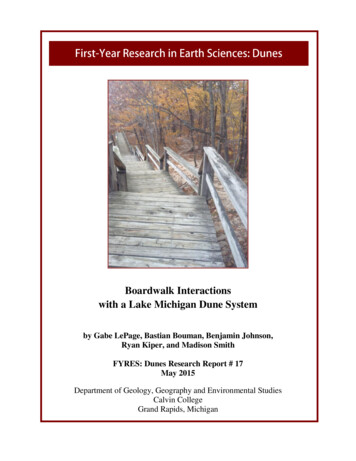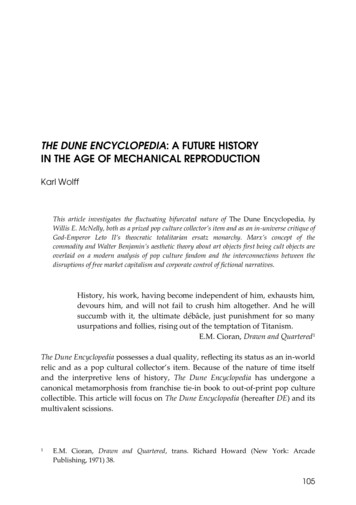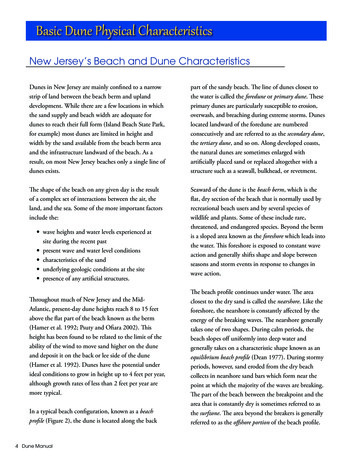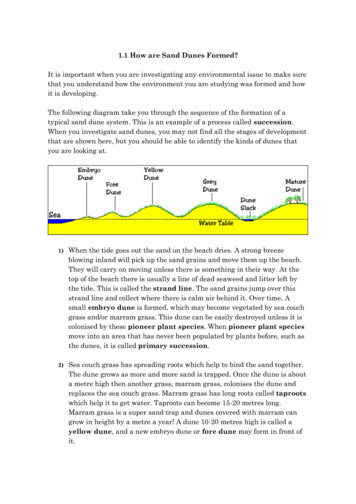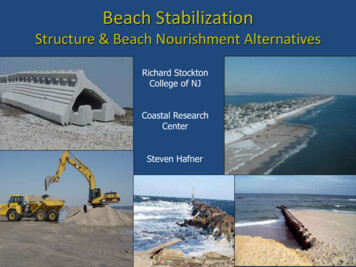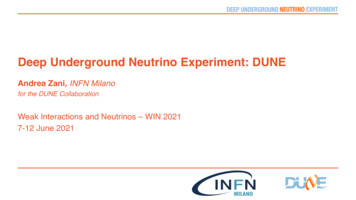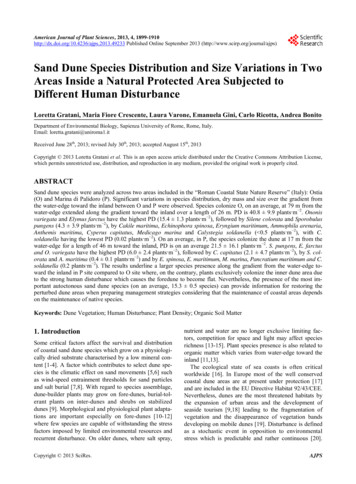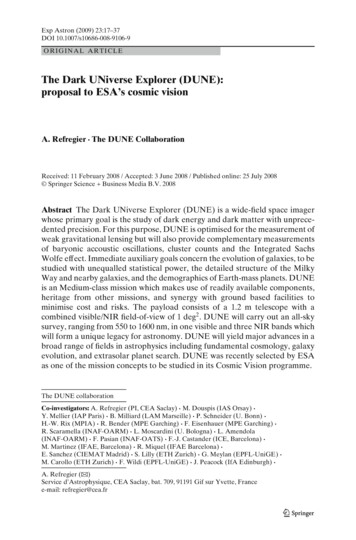
Transcription
Exp Astron (2009) 23:17–37DOI 10.1007/s10686-008-9106-9ORIGINAL ARTICLEThe Dark UNiverse Explorer (DUNE):proposal to ESA’s cosmic visionA. Refregier · The DUNE CollaborationReceived: 11 February 2008 / Accepted: 3 June 2008 / Published online: 25 July 2008 Springer Science Business Media B.V. 2008Abstract The Dark UNiverse Explorer (DUNE) is a wide-field space imagerwhose primary goal is the study of dark energy and dark matter with unprecedented precision. For this purpose, DUNE is optimised for the measurement ofweak gravitational lensing but will also provide complementary measurementsof baryonic accoustic oscillations, cluster counts and the Integrated SachsWolfe effect. Immediate auxiliary goals concern the evolution of galaxies, to bestudied with unequalled statistical power, the detailed structure of the MilkyWay and nearby galaxies, and the demographics of Earth-mass planets. DUNEis an Medium-class mission which makes use of readily available components,heritage from other missions, and synergy with ground based facilities tominimise cost and risks. The payload consists of a 1.2 m telescope with acombined visible/NIR field-of-view of 1 deg2 . DUNE will carry out an all-skysurvey, ranging from 550 to 1600 nm, in one visible and three NIR bands whichwill form a unique legacy for astronomy. DUNE will yield major advances in abroad range of fields in astrophysics including fundamental cosmology, galaxyevolution, and extrasolar planet search. DUNE was recently selected by ESAas one of the mission concepts to be studied in its Cosmic Vision programme.The DUNE collaborationCo-investigators: A. Refregier (PI, CEA Saclay) · M. Douspis (IAS Orsay) ·Y. Mellier (IAP Paris) · B. Milliard (LAM Marseille) · P. Schneider (U. Bonn) ·H.-W. Rix (MPIA) · R. Bender (MPE Garching) · F. Eisenhauer (MPE Garching) ·R. Scaramella (INAF-OARM) · L. Moscardini (U. Bologna) · L. Amendola(INAF-OARM) · F. Pasian (INAF-OATS) · F.-J. Castander (ICE, Barcelona) ·M. Martinez (IFAE, Barcelona) · R. Miquel (IFAE Barcelona) ·E. Sanchez (CIEMAT Madrid) · S. Lilly (ETH Zurich) · G. Meylan (EPFL-UniGE) ·M. Carollo (ETH Zurich) · F. Wildi (EPFL-UniGE) · J. Peacock (IfA Edinburgh) ·A. Refregier (B)Service d’Astrophysique, CEA Saclay, bat. 709, 91191 Gif sur Yvette, Francee-mail: refregier@cea.fr
18Exp Astron (2009) 23:17–37Keywords Cosmology · Dark energy · Dark matter · Legacy survey ·Wide field imager · Visible and near infra-red1 IntroductionOver the past decade, our large-scale view of the Universe has undergonea revolution. Cosmologists have agreed on a standard model that matches awide range of astronomical data (eg. [14]). However, this CDM concordancemodel relies on three ingredients whose origin and nature are unknown: darkmatter, dark energy and fundamental fields driving a period of inflation, duringwhich density fluctuations are imprinted on the Universe. All these elementsof the model represent new aspects of fundamental physics, which can best bestudied via astronomy. The nature of the dark energy, which now comprises thebulk of the mass-energy budget of the Universe, will determine the ultimatefate of the Universe and is among the deepest questions in physics.S. Bridle (UCL London) · M. Cropper (MSSL) · A. Taylor (IfA Edinburgh) ·J. Rhodes (JPL) · J. Hong (JPL) · J. Booth (JPL) · S. Kahn (U. Stanford)WG coordinators: A. Amara (CEA Saclay) · N. Aghanim (IAS Orsay) · J. Weller (UCL) ·M. Bartelmann (ZAH Heidelberg) · L. Moustakas (JPL) · R. Somerville (MPIA) ·E. Grebel (ZAH Heidelberg) · J.-P. Beaulieu (IAP Paris) · M. Della Valle (Arcetri) ·I. Hook (U. Oxford) · O. Lahav (UCL London) · A. Fontana (Roma) ·D. Bederede (CEA Saclay)Science: F. Abdalla (UCL) · R. Angulo (Durham) · V. Antonuccio (Catane) ·C. Baccigalupi (SISSA) · D. Bacon (U. Edinburgh) · M. Banerji (UCL) · E. Bell (MPIA) ·N. Benitez (Madrid) · S. Bonometto (Milano) · F. Bournaud (CEA Saclay) ·P. Capak (Caltech) · F. Casoli (IAS Orsay) · L. Colombo (Milano) · A. Cooray (UC Irvine) ·F. Courbin (EPFL) · E. Cypriano (UCL) · H. Dahle (Oslo) · R. Ellis (Caltech) ·T. Erben (Bonn) · P. Fosalba (ICE Barcelona) · R. Gavazzi (Santa Barbara/IAP) ·E. Gaztanaga (ICE Barcelona) · A. Goobar (Stockholm U.) · A. Grazian (Obs. Roma) ·A. Heavens (U. Edinburgh) · D. Johnston (JPL) · L. King (Cambridge) · T. Kitching (Oxford) ·M. Kunz (U. Geneva) · C. Lacey (Durham) · F. Mannucci (Firenze) ·R. Maoli (Rome) · C. Magneville (CEA Saclay) · S. Matarrese (U. Padova) ·P. Melchior (ZAH Heidelberg) · A. Melchiorri (U. Roma) · M. Meneghetti (Bologna) ·J. Miralda-Escude (ICE Barcelona) · A. Omont (IAP Paris) ·N. Palanque-Delabrouille (CEA Saclay) · S. Paulin-Henriksson (CEA Saclay) ·V. Pettorino (SISSA) · C. Porciani (ETH Zurich) · M. Radovich (Obs. Napoli) · A. Rassat(UCL/CEA Saclay) · R. Saglia (MPE) · D. Sapone (U. Geneva) ·C. Schimd (CEA Saclay) · J. Tang (UCL) · C. Tao (CPPM Marseille) · G. La Vacca (U. Milano) ·E. Vanzella (Obs. Trieste) · M. Viel (Trieste) · S. Viti (UCL) · L. Voigt (UCL) ·J. Wambsganss (ZAH Heidelberg)Instrument: E. Atad-Ettedgui (UKATC/ROE) · E. Bertin (IAP Paris) ·O. Boulade (CEA Saclay) · I. Bryson (UKATC/ROE) · C. Cara (CEA Saclay) ·L. Cardiel (IFAE) · A. Claret (CEA Saclay) ·E. Cortina (CIEMAT) · G. Dalton (Oxford/RAL) · C. Dusmesnil (IAS Orsay) ·J.-J. Fourmond (IAS Orsay) · K. Gilmore (Stanford) · . Hofmann (MPE) ·P.-O. Lagage (CEA Saclay) · R. Lenzen (MPIA) · A. Rasmussen (Stanford) ·S. Ronayette (CEA Saclay) · S. Seshadri (JPL) · Z.H. Sun (CEA Saclay) · H. Teplitz (IPAC) ·M. Thaller (IPAC) · I. Tosh (Rutherford Lab.) · H. Vaith (MPE) · A. Zacchei (Trieste)
Exp Astron (2009) 23:17–3719The most powerful tool that can be brought to bear on these problemsis weak gravitational lensing of distant galaxies; this forms the core of theDUNE mission.1 Gravitational deflection of light by intervening dark matterconcentrations causes the images of background galaxies to acquire an additional ellipticity of order of a percent, which is correlated over scales of tensof arcminutes. Measuring this signature probes the expansion history in twocomplementary ways: (1) geometrically, through the distance-redshift relation,and (2) dynamically, through the growth rate of density fluctuations in theUniverse.Utilisation of these cosmological probes relies on the measurement ofimage shapes and redshifts for several billion galaxies. The measurementof galaxy shapes for weak lensing imposes tight requirements on the imagequality which can only be met in the absence of atmospheric phase errorsand in the thermally stable environment of space. For this number of galaxies,distances must be estimated using photometric redshifts, involving photometrymeasurements over a wide wavelength range in the visible and near-IR. Thenecessary visible galaxy colour data can be obtained from the ground, usingcurrent or upcoming instruments, complementing the unique image qualityof space for the measurement of image distortions. However, at wavelengthsbeyond 1 μm, we require a wide NIR survey to depths that are only achievablefrom space.Given the importance of the questions being addressed and to providesystematic cross-checks, DUNE will also measure Baryon Acoustic Oscillations, the Integrated Sachs-Wolfe effect, and galaxy Cluster Counts. Combining these independent cosmological probes, DUNE will tackle the followingquestions: What are the dynamics of dark energy? What are the physicalcharacteristics of the dark matter? What are the seeds of structure formationand how did structure grow? Is Einstein’s theory of general relativity thecorrect theory of gravity?DUNE will combine its unique space-borne observation with existing andplanned ground-based surveys, and hence increases the science return of themission while limiting costs and risks. The panoramic visible and NIR surveysrequired by DUNE’s primary science goals will afford unequalled sensitivityand survey area for the study of galaxy evolution and its relationship withthe distribution of the dark matter, the discovery of high redshift objects, andof the physical drivers of star formation. Additional surveys at low galacticlatitudes will provide a unique census of the Galactic plane and earth-massexoplanets at distances of 0.5–5 AU from their host star using the microlensingtechnique. These DUNE surveys will provide a unique all-sky map in thevisible and NIR and thus complement other space missions such as Planck,WMAP, eROSITA, JWST, and WISE. The following describes the scienceobjectives, instrument concept and mission profile (see Table 1 for a baselinesummary). A description of an earlier version of the mission without NIR1 Forfurther information on DUNE: www.dune-mission.net.
20Exp Astron (2009) 23:17–37Table 1 DUNE Baseline summaryScience objectivesSurveysRequirementsPayloadService moduleSpacecraftOrbitLaunchOperationsMust: cosmology and dark energy. Should: galaxy formationCould: extra-solar planetsMust: 20,000 deg2 extragalactic, Should: Full sky (20,000 deg2 Galactic),100 deg2 medium-deep. Could: 4 deg2 planet hunting1 visible band (R I J) for high-precision shape measurements,3 NIR bands (Y, J, H) for photometry1.2 m telescope, Visible & NIR cameras with 0.5 deg2 FOV eachMars/Venus express, Gaia heritage2013kg launch massGeosynchronousSoyuz S-T Fregat4 year missioncapability and developped during a CNES phase 0 study can be found inRefregier et al. [12] and Grange et al. [13].2 Science objectivesThe DUNE mission will investigate a broad range of astrophysics and fundamental physics questions detailed below. Its aims are twofold: first study darkenergy and measure its equation of state parameter w (see definition below)and its evolution with a precision of 2% and 10% respectively, using bothexpansion history and structure growth, second explore the nature of darkmatter by testing the cold dark matter (CDM) paradigm and by measuringprecisely the sum of the neutrino masses. At the same time, it will test thevalidity of Einstein’s theory of gravity. In addition, DUNE will investigate howgalaxies form, survey all Milky-Way-like galaxies in the 2π extra-galactic skyout to z 2 and detect thousands of galaxies and AGN at 6 z 12. It willprovide a detailed visible/NIR map of the Milky Way and nearby galaxies andprovide a statistical census of exoplanets with masses above 0.1 Earth mass andorbits greater than 0.5 AU.2.1 Understanding dark energyA variety of independent observations overwhelmingly indicate that the cosmological expansion began to accelerate when the Universe was around halfof its present age. Presuming the correctness of general relativity this requiresa new energy component known as dark energy. The simplest case would beEinstein’s cosmological constant (Λ), in which the dark energy density wouldbe exactly homogeneous and independent of time. However, the description ofvacuum energy from current particle physics concepts conflicts by 120 orders ofmagnitude with the observed value, and the discrepancy is still not understood.Cosmologists are thus strongly motivated to consider models of a dynamical dark energy, or even to contemplate modifications to general relativity.
Exp Astron (2009) 23:17–3721Explaining dark energy may well require a radical change in our understandingof Quantum Theory or Gravity, or both. One of the major aims of DUNE isto determine empirically which of these alternatives is to be preferred. Theproperties of dark energy can be quantified by considering its equation of stateparameter w p/ρc2 , where p and ρ are its effective pressure and density.Unlike matter, dark energy has the remarkable property of having negativepressure (w 0) and thus of driving the Universe into a period of acceleratedexpansion (if w 1/3). The latter began relatively recently, around z 1.If the dark energy resembles a cosmological constant (w 1), it can onlybe directly probed in the low-redshift Universe (see Fig. 1). This expansionhistory can be measured in two distinct ways (see Fig. 1): (1) the distanceredshift relation D(z); (2) the growth of structure (i.e. galaxies and clustersof galaxies). The D(z) relation can be probed geometrically using ‘standardcandles’ such as supernovae, or via measures of the angular diameter distancefrom gravitational lensing or from the “standard rod” of Baryon AcousticOscillations (BAO). The accelerated expansion slows down the gravitationalgrowth of density fluctuations; this growth of structure can be probed bycomparing the amplitude of structure today relative to that when the CMBwas formed. Many models for dark energy and modifications to gravity havebeen proposed in which the equation of state parameter w vary with time.A convenient approximation is a linear dependence on the scale factor a 1/(1 z): w(a) wn (an a)wa , where wn is the value of the equation ofstate at a pivot scale factor an (close to 0.6 for most probes) and wa describesthe redshift evolution. The goal of future surveys is to measure wn and wato high precision. To judge their relative strengths we use a standard darkenergy figure of merit (FoM) [2], which we define throughout this proposal as:FoM 1/(Δwn Δwa ), where Δwn and Δwa are the (1σ ) errors on the equationof state parameters. This FoM is inversely proportional to the area of the errorellipse in the (wn wa ) plane.2.2 DUNE’s cosmological probesDUNE will deduce the expansion history from the two methods, distanceredshift relation and growth of structure. DUNE has thus the advantage ofprobing the parameters of dark energy in two independent ways. A singleaccurate technique can rule out many of the suggested members of the familyof dark energy models, but it cannot test the fundamental assumptions aboutgravity theory. If general relativity is correct, then either D(z) or the growthof structure can determine the expansion history. In more radical modelsthat violate general relativity, however, this equivalence between D(z) andgrowth of structure does not apply (see Fig. 1). For this purpose, DUNEwill use a combination of the following cosmological probes. The precisionon Dark Energy parameters achieved by DUNE’s weak lensing survey andcomplementary probes described below is shown in Fig. 2 and Table 2.
22Exp Astron (2009) 23:17–37Fig. 1 Effects of dark energy. Left fraction of the density of the universe in the form of darkenergy as a function of redshift z, for a model with a cosmological constant (w 1, black solidline), dark energy with a different equation of state (w 0.7, red dotted line), and a modifiedgravity model (blue dashed line). Dark energy becomes dominant in the low redshift universeera probed by DUNE, while the early Universe is probed by the CMB. Right growth factor ofstructures for the same models. Only by measuring the geometry (left panel) and the growth ofstructure (right panel) at low redshifts can a modification of dark energy be distinguished fromthat of gravity. Weak lensing measures both effectsWeak Lensing—A Dark Universe Probe: As light from galaxies travels towards us, its path is deflected by the intervening mass density distribution,causing the shapes of these galaxies to appear distorted by a few percent.The weak lensing method measures this distortion by correlating the shapesof background galaxies to probe the density field of the Universe. By dividinggalaxies into redshift (or distance) bins, we can examine the growth of structureand make three-dimensional maps of the dark matter. An accurate lensingsurvey, therefore, requires precise measurements of the shapes of galaxiesFig. 2 Left expected errors on the dark energy equation of state parameters for the four probesused by DUNE (68% statistical errors). The light blue band indicates the expected errors fromPlanck. Of the four methods, weak lensing clearly has the greatest potential. Right the combinationof BAO, CC and ISW (red solid line) begins to reach the potential of the lensing survey (bluedashed line) and provides an additional cross-check on systematics. The yellow ellipse correspondsto the combination of all probes and reaches a precision on dark energy of 2% on wn and10% on wa
Exp Astron (2009) 23:17–3723Table 2 Dark energy and initial conditions figures of merit for DUNE and PlanckDark energy sector wn waInitial conditions sector σ8 nsPlanck0.0330.030.004DUNE0.020.10.0060.01DUNE Planck0.010.050.0020.003Factor improvement of DUNE Planck over Planck onlyDEFoMICFoM1150020001808,00017,000170,00020as well as information about their redshifts. High-resolution images of largeportions of the sky are required, with low levels of systematic errors thatcan only be achieved via observations from a thermally stable satellite inspace. Analyses of the dark energy require precise measurements of both thecosmic expansion history and the growth of structure. Weak lensing standsapart from all other available methods because it is able to make accuratemeasurements of both effects. Given this, the optimal dark energy mission(and dark sector mission) is one that is centred on weak gravitational lensingand is complemented by other dark energy probes.Baryon Acoustic Oscillations (BAO)—An Expansion History Probe: Thescale of the acoustic oscillations caused by the coupling between radiation andbaryons in the early Universe can be used as a ’standard ruler’ to determine thedistance-redshift relation. Using DUNE, we can perform BAO measurementsusing photometric redshifts yielding the three-dimensional positions of a largesample of galaxies. All-sky coverage in the NIR enabled by DUNE, impossible from the ground, is crucial to reach the necessary photometric redshiftaccuracy for this BAO survey.Cluster Counts (CC)—A Growth of Structure Probe: Counts of the abundance of galaxy clusters (the most massive bound objects in the Universe) as afunction of redshift are a powerful probe of the growth of structure. There arethree ways to exploit the DUNE large-area survey, optimised for weak lensing,for cluster detection: strong lensing; weak lensing; and optical richness.Integrated Sachs–Wolfe (ISW) Effect—A Higher Redshift Probe: The ISWeffect is the change in CMB photon energy as it passes through achanging potential well. Its presence indicates either space curvature, adark energy component or a modification to gravity. The ISW effect ismeasured by cross-correlating the CMB with a foreground density fieldcovering the entire extra-galactic sky, as measured by DUNE. Becauseit is a local probe of structure growth, ISW will place complementaryconstraints on dark energy, at higher redshifts, relative to the otherprobes [6].
24Exp Astron (2009) 23:17–372.3 Understanding dark matterBesides dark energy, one major component of the concordance model ofcosmology is dark matter ( 90% of the matter in the Universe, and 25% ofthe total energy). The standard assumption is that the dark matter particle(s)is cold and non-collisional (CDM). Besides direct and indirect dark matterdetection experiments, its nature may well be revealed by experiments suchas the large hadron collider (LHC) at CERN, but its physical properties mayprove to be harder to pin down without astronomical input. one way of testingthis is to study the amount of substructure in dark matter halos on scales 1–100 , which can be done using high order galaxy shape measurements andstrong lensing with DUNE. Weak lensing measurements can constrain thetotal neutrino mass and number of neutrino species through observations ofdamping of the matter power spectrum on small scales. Combining DUNEmeasurements with Planck data would reduce the uncertainty on the sum ofneutrino masses to 0.04 eV, and may therefore make the first measurement ofthe neutrino mass [8].2.4 Understanding the seeds of structure formationIt is widely believed that cosmic structures originated from vacuum fluctuations in primordial quantum fields stretched to cosmic scales in a brief periodduring inflation. In the most basic inflationary models, the power spectrum ofthese fluctuations is predicted to be close to scale-invariant, with a spectralindex ns and amplitude parameterised by σ8 . As the Universe evolved, theseinitial fluctuations grew. CMB measurements probe their imprint on theradiation density at z 1,100. Density fluctuations continued to grow into thestructures we see today. Weak lensing observations with DUNE will lead to afactor of 20 improvement on the initial conditions as compared to CMB alone(see Table 2).2.5 Understanding Einstein’s gravityEinstein’s General Theory of Relativity, the currently accepted theory ofgravity, has been well tested on solar system and galactic scales. Variousmodifications to gravity on large scales (e.g. by extra dimensions, superstrings,non-minimal couplings or additional fields) have been suggested to avoid darkmatter and dark energy. The weak lensing measurements of DUNE will beused to test the underlying theory of gravity, using the fact that modifiedgravity theories typically alter the relation between geometrical measures andthe growth of structure (see Fig. 1). DUNE can measure the growth factorexponent γ with a precision of 2%.Meeting the above cosmological objectives necessitates an extra-galactic allsky survey (DASS-EX) in the visible/NIR with galaxies at a median redhiftof z 1. To this survey, will be added a shallower survey of the Galacticplane (DASS-G) which will complete the coverage to the full sky, as well
Exp Astron (2009) 23:17–3725as a medium-deep survey of 100 deg2 (DUNE-MD) and a pencil beammicrolensing survey for planets in the Galactic bulge.Focussed on the dark sector, DUNE will produce an invaluable broad survey legacy. DASS will cover a 10,000 times larger area than other optical/nearIR surveys of the same or better resolution, will be 4mag deeper than theGAIA photometry and six times higher resolution than the SDSS. In theinfrared, DASS-EX will be nearly 1,000 times deeper (in J) than the all-sky2MASS survey with an effective search volume which will be 5,000-fold thatof the UKIDDS large area survey currently underway, and 500-fold that ofthe proposed VISTA Hemisphere Survey. It would take VISTA 8,000 years tomatch DASS-EX depth and 20,000 deg2 area coverage. DASS-MD will bridgethe gap between DASS-EX and expected JWST surveys.2.6 Tracking the formation of galaxies and AGN with DUNEWhile much progress has been made in understanding the formation of largescale structure, there are still many problems in forming galaxies within thisstructure with the observed luminosity function and morphological properties.This is now a major problem in astronomy. Obtaining deep high spatialresolution near-IR images will be central to the study galaxy morphologyand clustering. A large area survey is required for rare but important events,such as the merger rate of very massive galaxies. DUNE will deliver this keycapability.Using DUNE’s weak lensing maps, we will study the relationship betweengalaxy mass and light, the bias, by mapping the total mass density and thestellar mass and luminosity. Galaxy clusters are the largest scale signpostsof structure formation. While at present only a few massive clusters at z 1are known, DUNE will find hundreds of Virgo-cluster-mass objects at z 2,and several thousand clusters of M 1 2 1013 Msun . The latter are the likelyenvironments in which the peak of QSO activity at z 2 takes place, and holdthe empirical key to understanding the heyday of QSO activity.Using the Lyman-dropout technique in the near-IR, the DUNE-MDsurvey will be able to detect the most luminous objects in the earlyUniverse (z 6): 104 star-forming galaxies at z 8 and up to 103 atz 10, for SFRs 30 100M /yr. It will also be able to detect significant numbers of high-z quasars: up to 104 at z 7, and 103 at z 9.These will be central to understanding the reionisation history of theUniverse.Dune will also detect a very large number of strong lensing systems: about105 galaxy-galaxy lenses, 103 galaxy-quasar lenses and 5,000 strong lensing arcsin clusters (see [9]). It is also estimated that several tens of galaxy-galaxy lenseswill be double Einstein rings [7], which are powerful probes of the cosmologicalmodel as they simultaneously probe several redshifts.In addition, during the course of the DUNE-MD survey (over 6 months), weexpect to detect 3,000 Type Ia Supernovae with redshifts up to z 0.6 and acomparable number of Core Collapse SNe (Types II and Ib/c) out to z 0.3.
26Exp Astron (2009) 23:17–37This will lead to measurement of SN rates thus providing information on theirprogenitors and on the star formation history.2.7 Studying the Milky Way with DUNEDUNE is also primed for a breakthrough in Galactic astronomy. DASS-EX,complemented by the shallower survey of the Galactic plane (with b 30deg) will provide all-sky high resolution (0.23 in the wide red band, and 0.4 in YJH) deep imaging of the stellar content of the Galaxy, allowing the deepestdetailed structural studies of the thin and thick disk components, the bulge/bar,and the Galactic halo (including halo stars in nearby galaxies such as M31 andM33) in bands which are relatively insensitive to dust in the Milky Way.DUNE will be little affected by extinction and will supersede by ordersof magnitude all of the ongoing surveys in terms of angular resolution andsensitivity. DUNE will thus enable the most comprehensive stellar censusof late-type dwarfs and giants, brown dwarfs, He-rich white dwarfs, alongwith detailed structural studies, tidal streams and merger fragments. DUNE’ssensitivity will also open up a new discovery space for rare stellar and lowtemperature objects via its H-band imaging. Currently, much of Galactic structure studies are focussed on the halo. Studying the Galactic disk componentsrequires the combination of spatial resolution (crowding) and dust-penetration(H-band) that DUNE can deliver.Beyond our Milky Way, DUNE will also yield the most detailed andsensitive survey of structure and substructure in nearby galaxies, especially oftheir outer boundaries, thus constraining their merger and accretion histories.2.8 Search for exo-planetsThe discovery of extrasolar planets is the most exciting development in astrophysics over the past decade, rivalled only by the discovery of the accelerationof the Universe. Space observations (e.g. COROT, KEPLER), supportedby ground-based high-precision radial velocity surveys will probe low-massplanets (down to 1M ). DUNE is also perfectly suited to trace the distributionof matter on very small scales those of the normally invisible extrasolarplanets. Using microlensing effect, DUNE can provide a statistical census ofexoplanets in the Galaxy with masses over 0.1M from orbits of 0.5 AU tofree-floating objects. This includes analogues to all the solar system’s planetsexcept for Mercury, as well as most planets predicted by planet formationtheory. Microlensing is the temporary magnification of a Galactic bulge sourcestar by the gravitational potential of an intervening lens star passing near theline of sight. A planet orbiting the lens star, will have an altered magnification,showing a brief flash or a dip in the observed light curve of the star (seeFig. 3). Because of atmospheric seeing (limiting the monitoring to large sourcestars), and poor duty cycle even using networks, ground-based microlensingsurveys are only able to detect a few to 15 M planets in the vicinity of theEinstein ring radius (2–3 AU). The high angular resolution of DUNE, and
Exp Astron (2009) 23:17–3727Fig. 3 Exoplanet discoveryparameter space (planet massvs orbit size) showing forreference the eight planetsfrom our solar system (labeledas letters), those detected byDoppler wobble (T), transit(circle), and microlensing. Weoutline regions that can beprobed by different methods.Note the uniqueness of theparameter space probed byDUNE compared to othertechniquesthe uninterrupted visibility and NIR sensitivity afforded by space observationswill provide detections of microlensing events using as sources G and K bulgedwarfs stars and therefore can detect planets down to 0.1 1M from orbits of0.5 AU. Moreover, there will be a very large number of transiting hot Jupitersdetected towards the Galactic bulge as ‘free’ ancillary science. A space-basedmicrolensing survey is thus the only way to gain a comprehensive census andunderstanding of the nature of planetary systems and their host stars. We alsounderline that the planet search scales linearly with the surface of the focalplane and the duration of the experiment.3 DUNE surveys: the need for all-sky imaging from spaceThere are two key elements to a high precision weak lensing survey: a largesurvey area to provide large statistics, and the control of systematic errors.Figure 4 shows that to reach our dark energy target (2% error on wn ) a surveyof 20,000 square degrees with galaxies at z 1 is required. This result is basedon detailed studies showing that, for a fixed observing time, the accuracy ofall the cosmological parameters is highest for a wide rather than deep survey[3, 4]. This required survey area drives the choice of a 1.2 m telescope and acombined visible/NIR FOV of 1 deg2 for the DUNE baseline.Ground based facilities plan to increase area coverage, but they willeventually be limited by systematics inherent in ground based observations(atmospheric seeing which smears the image, instabilities of ground basedPSFs, telescope flexure and wind-shake, and inhomogeneous photometriccalibrations arising from seeing fluctuations). The most recent ground-basedwide field imagers (e.g. MegaCam on CFHT, and Subaru) have a stochasticvariation of the PSF ellipticity of the order of a few percent, i.e. of the
28Exp Astron (2009) 23:17–37DES (griz)DES (griz) spec312z spec3Fig. 4 Left error on the dark energy equation of state parameter wn as a function of weak lensingsurvey area
DUNE will carry out an all-sky survey, ranging from 550 to 1600 nm, in one visible and three NIR bands which will form a unique legacy for astronomy. DUNE will yield major advances in a broad range of fields in astrophysics including fundamental cosmology, galaxy evolution, and extrasolar planet search. DUNE was recently selected by ESA

